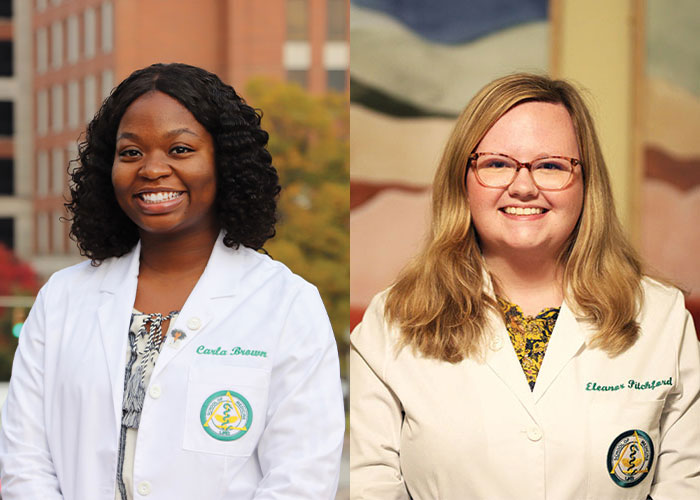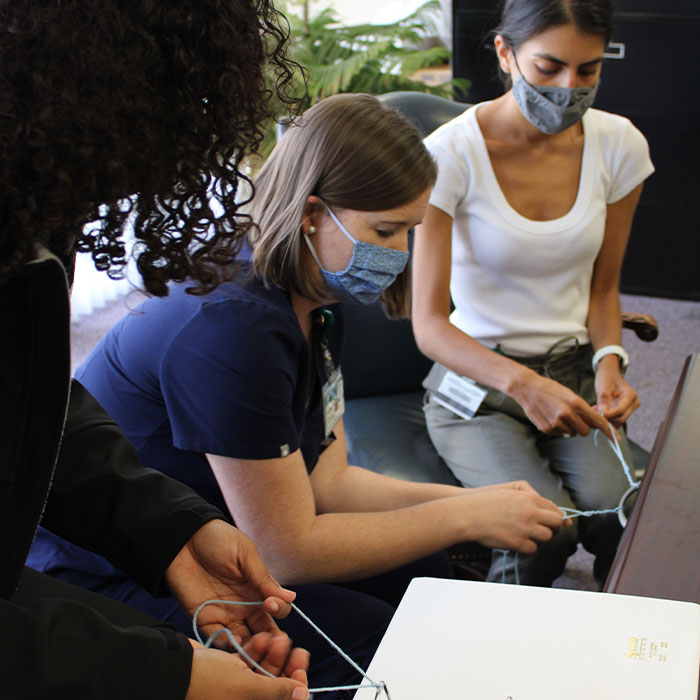When they look toward their future in medicine, UAB Heersink School of Medicine students Carla Brown and Ellie Pitchford both envision practicing medicine in rural communities similar to the ones that shaped them.
Growing up in Batesville, Mississippi, Brown, who will complete her third and fourth years at the school’s Tuscaloosa Regional Medical Campus, saw how people in the small, rural town cared for each other, but also how they struggled to access high quality, timely medical care, particularly if they needed to see specialists or were facing an emergency. Left to right: Carla Brown and Ellie Pitchford
Left to right: Carla Brown and Ellie Pitchford
“We have one or two family medicine physicians who I have known my whole life, and a small hospital that has threatened to close several times. We do not have a lot of specialties; they just got rid of labor and delivery,” Brown says. “Growing up in that environment, I have seen several people in life-or-death situations need to get to the nearest hospital with specialists who can treat them and unfortunately pass before they can make it there.”
Raised roughly 200 miles from Birmingham in Scottsboro, Alabama, Ellie Pitchford noticed similar trends as friends and family sought medical care. “My grandparents often had to travel 45 minutes to see their primary care provider,” says Pitchford, who lived in Scottsboro until age 21, when her family moved to Birmingham. “There is also a significant lack of mental health resources in rural communities, something that I would like to address as a provider and make available to my patients.”
A lack of access to primary care is a growing problem in Alabama’s rural areas. “Currently, our state needs more than 600 additional primary care providers to meet the needs of the patients and the kinds of health conditions that we will be seeing by 2030,” says Irfan Asif, M.D., chair of the Department of Family and Community Medicine and associate dean for Primary Care and Rural Health. “To address this deficit, we must be aggressive in the family medicine and primary care programming that we develop and implement.”
Both Brown and Pitchford are first-year students and members of the latest cohort of the UAB Department of Family and Community Medicine’s Comprehensive Urban Underserved and Rural Experience program, or CU2RE. Launched in 2020 through a $7 million grant from the Health Resources and Services Administration, CU2RE is designed to enhance the recruitment, training and retention of medical students dedicated to serving as family medicine physicians in underserved rural and urban areas of Alabama. In 2021, CU2RE was awarded $5.2 million in supplemental funding from HRSA to expand and continue its mission and support programming around the state.
The program admitted a second cohort of 16 students in fall 2021, including Brown and Pitchford, after launching with an inaugural cohort of eight students in 2020. Students, who can choose between an urban underserved and rural medicine track, remain in the program throughout their four years in medical school. They are paired with a dedicated mentor and complete web-based modules, have monthly early clinical experiences with a family medicine preceptor, and work through an intensive summer program during their first two years, along with a four-week Family Medicine Clerkship in their third year and a four-week Family Medicine Acting Internship in their fourth year. A hallmark of the program is a 10 patient panel that each student will care for to improve the quality of their health through methods such as health coaching. CU2RE participants took part in a dermatology workshop in summer 2021.
CU2RE participants took part in a dermatology workshop in summer 2021.
“I am excited about getting a lot more hands-on experience early in medical school and about the mentorship aspect of the program,” Brown says. “I did not really have a lot of guidance getting to medical school, so it was very important to me to find that here. I am also excited to be with others who are interested in primary care and family medicine, to bounce ideas off each other and share experiences that might be different from those I have had.”
Pitchford, who will complete her clinical years at the Huntsville Regional Medical Campus, says she applied to CU2RE because she is “hungry for clinical opportunities to start serving people now, instead of having to wait.”
“Growing up, I always saw the doctors [in Scottsboro] use medicine as a way to serve people and that is what attracted me to medicine,” she says. “If I am going to spend all of this time in school, I want to come out of it able to serve people and serve some of the most vulnerable populations, including rural people.”
Both women believe that an influx of family medicine and primary care physicians, supported by programs like CU2RE, can help solve some of the problems patients face in rural areas. “I saw a lot of health disparities in my community, which really made me want to practice in a similar area,” Brown says. There are a lot of different challenges, she said, from gaps in communication that keep patients and providers from understanding the patients’ concerns and how to treat them, to logistical challenges like transportation to and from appointments.
Pitchford also wants to make one thing clear to her classmates and fellow aspiring physicians: providing care in rural communities is challenging, meaningful, and valuable work. “I think sometimes there is this expectation or bias that medical students who are interested in rural medicine are limiting themselves or taking the easy route,” she says. “I want people to be encouraged. You are not limiting yourself in rural medicine. Medicine is all about serving the patient and you will do that every day.” – By Caroline Newman